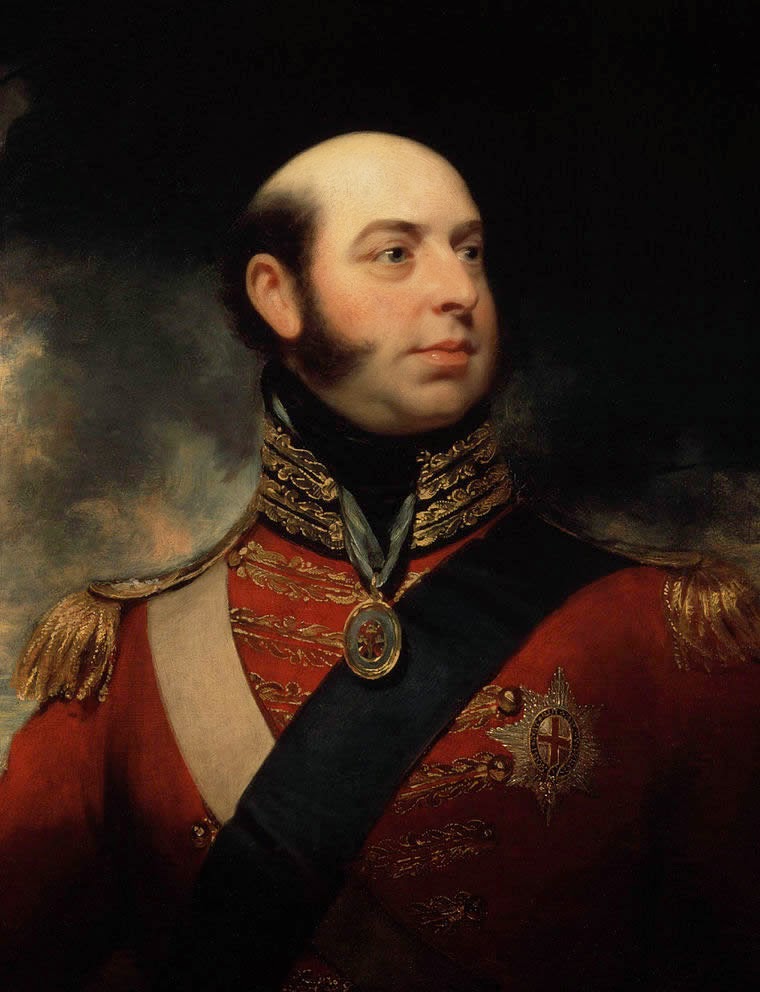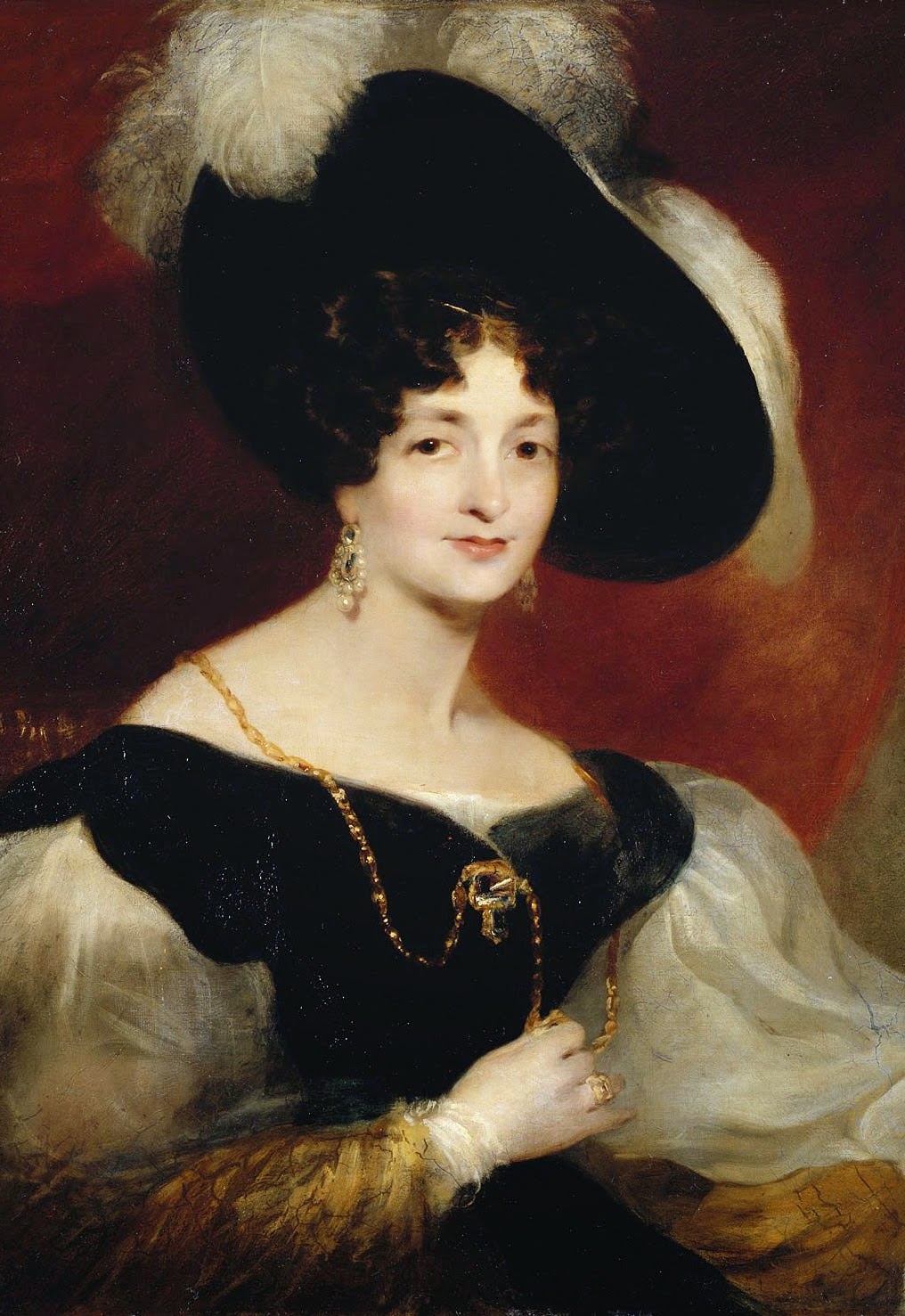 |
| Queen Victoria |
Queen Victoria was born May 24, 1819, acceded to the throne on June 20, 1837 (succeeding William IV), and died January 22, 1901 (succeeded by Edward VII). The woman who wore the crown of the United Kingdom through six decades of great political, economic, and social change in Britain and elsewhere might never have been born at all were it not for a dynastic crisis in 1817.
That year, Princess Charlotte, the daughter of the Prince of Wales and second in line to inherit the throne, died due to complications from giving birth, during which her baby also died. Despite the fact that George III and his queen had 15 children, 12 of whom were still alive in 1817, Charlotte had been their only surviving legitimate grandchild.
There were many illegitimate children, such as Prince William’s 10 Fitz Clarences, but these were excluded from the succession. Charlotte’s death thus created a major problem for the Hanoverian line. The king was an incapacitated old man, and his children were mostly unmarried and all in their 40s and 50s, not the prime time to start a family.
Nevertheless, the solution was for the unmarried sons of George III to leave their mistresses behind, marry women of appropriate status, and serve their country by producing as many living heirs as possible. As an incentive, Parliament agreed to alleviate some of the debts of the princes if they would settle into family life.
 |
| Prince Edward Augustus, the duke of Kent and Strathearn, the father of Queen Victoria |
Prince Edward Augustus, the duke of Kent and Strathearn, the father of Queen Victoria, had both financial problems and a mistress. His long, stable, and loving relationship with the French gentlewoman Julie de St. Laurent was practically a common-law marriage, but this counted for nothing in the royal succession.
Legislation such as the Settlement Act of 1701 and the Royal Marriages Act of 1772 placed major restrictions on the choice of marriage partners for members of the royal family, and as a French Catholic without suitable pedigree, Julie was an inappropriate choice on many counts.
So Edward, like virtually all of his brothers, went looking for a German Protestant princess to take as his wife. He found Victoria of Saxe-Coburg-Saalfeld, a widow and the sister of Prince Leopold, the widower of Princess Charlotte.
 |
| Victoria of Saxe-Coburg-Saalfeld, the sister of Prince Leopold, the mother of Queen Victoria |
The couple was married in 1818, and Victoria was born in May 1819. Within a matter of months, other hastily arranged royal matches also produced children, but since none from the more senior dynastic lines survived infancy, Victoria was soon considered to be the most likely grandchild of George III to inherit the throne.
The old king died early in 1820, followed within a week by the duke of Kent. Victoria was thus fatherless from infancy. Her mother, the duchess of Kent, sought to keep her isolated from the courts of both George IV and William IV, partly because she wished to shield her daughter from the corruption of courtly life and partly due to chilly personal relations between the duchess and most of the royal family. Later in life, Victoria would remember George, William, and the other sons of George III as her “wicked uncles.”
The young princess also faced problems closer to home. Her mother was loving but domineering, and she was guided by Sir John Conroy, a former equerry of the duke who became comptroller of the household. There were rumors that Conroy was the duchess’s lover, but in any case, he certainly carried a great deal of influence over her.
The two sought increasingly higher pensions from the government (which they would manage on the young princess’s behalf) and also tried to ensure that they would have complete control of the regency if Victoria came to the throne before she turned 18.
The two people to whom Victoria looked for guidance and compassion were her German governess, Baroness Lehzen, and her maternal uncle, Prince Leopold. In 1830 Leopold was chosen to become king of the newly independent Belgium, and he continued to provide his niece with advice and support throughout his life.
Era of Great Changes
In the summer of 1837 William IV died, secure in the knowledge that Victoria had passed her 18th birthday, and would no longer be subject to the domination of her mother and Conroy. Victoria came to the throne in an era of great changes.
A number of European countries had experienced political revolutions in 1830; the British political landscape had been altered by the 1832 Reform Bill and other initiatives of the Whig government, paving the way for popular demands for even further change, in the form of the Chartist movement. The Industrial Revolution was changing the British economy and the condition of its cities and people.
Practical, steam-driven railways were barely a decade old, but the network of rails rapidly spread across the country. Some people worried that a young “girl” (in the parlance of the time) could not effectively rule a modern, industrial, and imperial state.
As it was, in the early years of her reign Victoria relied heavily on the guidance of her first prime minister, the Whig Lord Melbourne. This posed great risks to the supposed impartiality of the sovereign in the operation of the British constitution.
Many conservatives saw the Bedchamber Crisis of 1839, when the queen refused to accept the changes to her household personnel proposed by the Tory leader Robert Peel, as proof of her Whig sympathies. At the time, the queen disliked Peel intensely, but she would grow to respect his abilities later. For the moment, however, her lack of cooperation led Peel to refuse to form a government and kept Melbourne and the Whigs in power for two more years.
Romantic Match
In 1840 Victoria married her first cousin, Albert of Saxe-Coburg and Gotha. Some had suggested that her husband should be chosen for diplomatic reasons, but the queen opted for a romantic match. Although the personalities of the queen and her new husband differed in many respects, their partnership was very effective in both political and domestic affairs.
 |
| Queen victoria and her family |
Albert was somewhat shy and intellectual and never tired of paperwork; Victoria was more outgoing and temperamental and did not mind ceremonies and state functions as Albert did. Together they oversaw the management of the royal family and household, as well as making the monarchy more active and visible in society at large.
The Victoria Cross was created during the Crimean War to recognize the courage and sacrifice of British soldiers fighting in her name. The Great Exhibition of 1851, which showcased machinery and products from around the world, but above all the ascendancy of Britain’s industrial might, was heavily influenced by Albert’s energy and enthusiasm.
The couple had nine children: Victoria, born in 1840; Albert Edward, the future Edward VII, 1841; Alice, 1842; Alfred, 1844; Helena, 1846; Louise, 1848; Arthur, 1850; Leopold, 1853; and Beatrice, 1857. Although Albert invested so much energy and time in trying to raise Albert Edward (known as Bertie) to be a good king someday, the prince was a constant source of disappointment to both of his parents.
Even so, the Prince of Wales and his siblings were often sent to distant parts of the empire as emissaries of their mother, which helped to reinforce the sentimental attachment of settler colonies in Canada, Australia, and South Africa to the home country.
Albert’s death in 1861 had an enormous influence on Victoria for the rest of her life. Out of devotion to him, she insisted that the routines that were followed while he was alive continue, including making up his rooms and putting out hot water for shaving and washing.
She largely retreated from public appearances for decades, except for the unveiling of monuments to Albert around the country. Her continued use of public funds without performing a public role led to popular criticism of the queen and the monarchy as an institution, especially in the 1870s.
Many scholars argue that lacking Albert’s counsel, her behavior in politics also changed; whereas during their marriage the royal couple had generally sought to remain above party and to work dutifully with the government of the day, in widowhood Victoria began to show a marked preference for the Conservative Party (especially Benjamin Disraeli) and more antipathy to the Liberals (especially William Gladstone).
She could not singlehandedly decide who would form the government, as some of her predecessors had, but she could make day-to-day administration more or less difficult depending on her prejudices.
Victoria also grew close to two of her male servants: first the Scottish highlander John Brown, with whom many contemporaries and some historians assumed she had an affair, and later the Indian Abdul Karim.
Regardless of the precise nature of her relationships with these men, there is no doubt that she was very attached to each of them in turn and found a measure of comfort for her loneliness in their company. At the same time, some people believed that she was being manipulated by such confidants, and her image as Mrs. Brown added fuel to the criticism of the monarchy in the 1870s.
Her popularity was salvaged to a large extent through her increasing association with imperialism and British prestige abroad. Disraeli arranged for her to assume the title of empress of India in 1876, and she became the centerpiece of the great pageants that marked her two jubilees.
 |
| The Victoria Cross |
By this time she had also become the “Grandmother of Europe,” through her children and grandchildren marrying into the royal families of Germany, Russia, Sweden, Denmark, Greece, Spain, and Romania. By her death at the beginning of the 20th century, Britain was a preeminent global power in political, economic, and military terms, as nearly all of her obituaries declared.
These accomplishments were not the queen’s own doing, nor did they only begin to develop after she took the throne. But the great length of her life and reign provided a reassuring veneer of stability and timelessness to an age that saw great and unpredictable changes in every field of human activity, from technology to women’s rights.
The queen herself was not always an advocate of such transformations, but in the popular imagination her name and image became inextricably linked with the period and all that happened within it.
The life and times of Queen Victoria continue to fascinate historians and nonhistorians alike. The queen herself is still one of the most talked- and written-about women in history. According to her biographer Walter Arnstein, “only the Virgin Mary, Joan of Arc, and Jane Austen ranked ahead of the queen” in the holdings of the Library of Congress.
She was a complex personality, and the firsthand documentary record is vast, encompassing her own diaries, letters, and published works, as well as official papers and the memoirs of many of the people who lived and worked with her over eight decades. With the passage of time and new sources being uncovered, the discussion of Victoria has continually been fed with new opinions and reevaluations.
Her biographers are both numerous and diverse: They include a jaded intellectual (Lytton Strachey), a Catholic aristocrat (Elizabeth Longford), and a feminist and communist historian (Dorothy Thompson). Regardless of perspective, most biographers have found both commendable and faulty elements in the queen’s character, and it appears likely that the interest in Queen Victoria will continue for a long time to come.